Novel Three-Dimensional Graphene-Like Networks Loaded with Fe3O4 Nanoparticles for Efficient Microwave Absorption
Abstract
1. Introduction
2. Materials and Methods
2.1. Fabrication
2.2. Characterization
3. Results
3.1. The Structure Analysis
3.2. Magnetic Properties
3.3. Microwave Absorbing Properties
4. Conclusions
Author Contributions
Funding
Institutional Review Board Statement
Informed Consent Statement
Data Availability Statement
Conflicts of Interest
References
- Quan, L.; Qin, F.X.; Estevez, D.; Wang, H.; Peng, H.X. Magnetic graphene for microwave absorbing application: Towards the lightest graphene-based absorber. Carbon 2017, 125, 630–639. [Google Scholar] [CrossRef]
- Wu, J.; Ye, Z.; Liu, W.; Liu, Z.; Chen, J. The effect of GO loading on electromagnetic wave absorption properties of Fe3O4/reduced graphene oxide hybrids. Ceram. Int. 2017, 43, 13146–13153. [Google Scholar] [CrossRef]
- Zheng, Y.; Wang, X.; Wei, S.; Zhang, B.; Yu, M.; Zhao, W.; Liu, J. Fabrication of porous graphene-Fe3O4 hybrid composites with outstanding microwave absorption performance. Compos. Part A Appl. Sci. 2017, 95, 237–247. [Google Scholar] [CrossRef]
- Wang, C.; Han, X.; Xu, P.; Zhang, X.; Du, Y.; Hu, S.; Wang, J.; Wang, X. The electromagnetic property of chemically reduced graphene oxide and its application as microwave absorbing material. Appl. Phys. Lett. 2011, 98, 072906. [Google Scholar] [CrossRef]
- Lai, Y.; Wang, S.; Qian, D.; Zhong, S.; Wang, Y.; Han, S.; Jiang, W. Tunable electromagnetic wave absorption properties of nickel microspheres decorated reduced graphene oxide. Ceram. Int. 2017, 43, 12904–12914. [Google Scholar] [CrossRef]
- Hu, C.; Mou, Z.; Lu, G.; Chen, N.; Dong, Z.; Hu, M.; Qu, L. 3D graphene-Fe3O4 nanocomposites with high-performance microwave absorption. Phys. Chem. Chem. Phys. 2013, 15, 13038–13043. [Google Scholar] [CrossRef] [PubMed]
- Zhou, H.; Wang, J.; Zhuang, J.; Liu, Q. A covalent route for efficient surface modification of ordered mesoporous carbon as high performance microwave absorbers. Nanoscale 2013, 5, 12502–12511. [Google Scholar] [CrossRef] [PubMed]
- Cheng, J.; Li, Y.; Huang, X.; Wang, Q.; Mei, A.; Shen, P.K. Highly stable electrocatalysts supported on nitrogen-self-doped three-dimensional graphene-like networks with hierarchical porous structures. J. Mater. Chem. A 2015, 3, 1492–1497. [Google Scholar] [CrossRef]
- Li, Y.; Li, Z.; Shen, P.K. Simultaneous Formation of Ultrahigh Surface Area and Three-Dimensional Hierarchical Porous Graphene-Like Networks for Fast and Highly Stable Supercapacitors. Adv. Mater. 2013, 25, 2474–2480. [Google Scholar] [CrossRef]
- Li, Y.; Zhang, H.; Chen, Y.; Shi, Z.; Cao, X.; Guo, Z.; Shen, P.K. Nitrogen-Doped Carbon-Encapsulated SnO2@Sn Nanoparticles Uniformly Grafted on Three-Dimensional Graphene-like Networks as Anode for High-Performance Lithium-Ion Batteries. ACS Appl. Mater. Interfaces 2016, 8, 197–207. [Google Scholar] [CrossRef] [PubMed]
- Qu, B.; Zhu, C.; Li, C.; Zhang, X.; Chen, Y. Coupling hollow Fe3O4-Fe nanoparticles with graphene sheets for high-performance electromagnetic wave absorbing material. ACS Appl. Mater. Interfaces 2016, 8, 3730–3735. [Google Scholar] [CrossRef] [PubMed]
- Wang, X.-X.; Ma, T.; Shu, J.-C.; Cao, M.-S. Confinedly tailoring Fe3O4 clusters-NG to tune electromagnetic parameters and microwave absorption with broadened bandwidth. Chem. Eng. J. 2018, 332, 321–330. [Google Scholar] [CrossRef]
- Zhu, L.; Zeng, X.; Li, X.; Yang, B.; Yu, R. Hydrothermal synthesis of magnetic Fe3O4/graphene composites with good electromagnetic microwave absorbing performances. J. Magn. Magn. Mater. 2017, 426, 114–120. [Google Scholar] [CrossRef]
- Li, Z.; Li, Y.; Jiang, S.P.; He, G.; Shen, P.K. Novel graphene-like nanosheet supported highly active electrocatalysts with ultralow Pt loadings for oxygen reduction reaction. J. Mater. Chem. A 2014, 2, 16898–16904. [Google Scholar] [CrossRef]
- Li, Y.; Zhang, Q.; Zhu, J.; Wei, X.-L.; Shen, P.K. An extremely stable MnO2 anode incorporated with 3D porous graphene-like networks for lithium-ion batteries. J. Mater. Chem. A 2014, 2, 3163–3168. [Google Scholar] [CrossRef]
- Li, Y.; Ou, C.; Huang, Y.; Shen, Y.; Li, N.; Zhang, H. Towards fast and ultralong-life Li-ion battery anodes: Embedding ultradispersed TiO2 quantum dots into three-dimensional porous graphene-like networks. Electrochim. Acta 2017, 246, 1183–1192. [Google Scholar] [CrossRef]
- Li, Y.; Zhang, H.; Wang, S.; Lin, Y.; Chen, Y.; Shi, Z.; Li, N.; Wang, W.; Guo, Z. Facile low-temperature synthesis of hematite quantum dots anchored on a three-dimensional ultra-porous graphene-like framework as advanced anode materials for asymmetric supercapacitors. J. Mater. Chem. A 2016, 4, 11247–11255. [Google Scholar] [CrossRef]
- Zhan, T.T.; Jiang, W.F.; Li, C.; Luo, X.D.; Lin, G.; Li, Y.W.; Xiao, S.H. High performed composites of LiFePO4/3DG/C based on FePO4 by hydrothermal method. Electrochim. Acta 2017, 246, 322–328. [Google Scholar] [CrossRef]
- Zeng, X.; Yang, B.; Yang, H.; Zhu, L.; Yu, R. Solvothermal synthesis and good microwave absorbing properties for magnetic porous-Fe3O4/graphene nanocomposites. AIP Adv. 2017, 7, 056605. [Google Scholar] [CrossRef]
- Kumar, R.; Singh, R.K.; Vaz, A.R.; Savu, R.; Moshkalev, S.A. Self-assembled and one-step synthesis of interconnected 3d network of Fe3O4/reduced graphene oxide nanosheets hybrid for high performance supercapacitor electrode. ACS Appl. Mater. Interfaces 2017, 9, 8880–8890. [Google Scholar] [CrossRef] [PubMed]
- Yan, S.; Wang, L.; Wang, T.; Zhang, L.; Li, Y.; Dai, S. Synthesis and microwave absorption property of graphene oxide/carbon nanotubes modified with cauliflower-like Fe3O4 nanospheres. Appl. Phys. A 2016, 122, 235. [Google Scholar] [CrossRef]
- Geng, Z.; Lin, Y.; Yu, X.; Shen, Q.; Ma, L.; Li, Z.; Pan, N.; Wang, X. Highly efficient dye adsorption and removal: A functional hybrid of reduced graphene oxide-Fe3O4 nanoparticles as an easily regenerative adsorbent. J. Mater. Chem. 2012, 22, 3527. [Google Scholar] [CrossRef]
- Wei, S.; Chen, T.; Wang, Q.; Shi, Z.; Li, W.; Chen, S. Metal-organic framework derived hollow CoFe@C composites by the tunable chemical composition for efficient microwave absorption. J. Colloid Interface Sci. 2021, 593, 370–379. [Google Scholar] [CrossRef] [PubMed]
- Lv, H.; Ji, G.; Liang, X.; Zhang, H.; Du, Y. A novel rod-like MnO2@Fe loading on graphene giving excellent electromagnetic absorption properties. J. Mater. Chem. C 2015, 3, 5056–5064. [Google Scholar] [CrossRef]
- Ren, X.; Xu, G. Electromagnetic and microwave absorbing properties of NiCoZn-ferrites doped with La3+. J. Magn. Magn. Mater. 2014, 354, 44–48. [Google Scholar] [CrossRef]
- Liu, L.; Duan, Y.; Liu, S.; Chen, L.; Guo, J. Microwave absorption properties of one thin sheet employing carbonyl-iron powder and chlorinated polyethylene. J. Magn. Magn. Mater. 2010, 322, 1736–1740. [Google Scholar] [CrossRef]
- Shang, T.; Lu, Q.; Chao, L.; Qin, Y.; Yun, Y.; Yun, G. Effects of ordered mesoporous structure and La-doping on the microwave absorbing properties of CoFe2O4. Appl. Surf. Sci. 2018, 434, 234–242. [Google Scholar] [CrossRef]
- Li, J.; Ji, H.; Xu, Y.; Zhang, J.; Yan, Y. Three-dimensional graphene supported Fe3O4 coated by polypyrrole toward enhanced stability and microwave absorbing properties. J. Mater. Res. Technol. 2020, 9, 762–772. [Google Scholar] [CrossRef]
- Zhao, T.; Ji, X.; Jin, W.; Wang, C.; Ma, W.; Gao, J.; Dang, A.; Li, T.; Shang, S.; Zhou, Z. Direct in situ synthesis of a 3d interlinked amorphous carbon nanotube/graphene/BaFe12O19 composite and its electromagnetic wave absorbing properties. RSC Adv. 2017, 7, 15903–15910. [Google Scholar] [CrossRef]
- Du, Z.; Chen, X.; Zhang, Y.; Que, X.; Zhai, M. One-pot hydrothermal preparation of Fe3O4 decorated graphene for microwave absorption. Materials 2020, 13, 3065. [Google Scholar] [CrossRef] [PubMed]
- Cui, G.; Lu, Y.; Zhou, W.; Lv, X.; Hu, J.; Zhang, G.; Gu, G. Excellent microwave absorption properties derived from the synthesis of hollow Fe3O4@reduced graphite oxide (RGO) nanocomposites. Nanomaterials 2019, 9, 141. [Google Scholar] [CrossRef]
- Wang, Y.; Wu, X.; Zhang, W.; Luo, C.; Li, J.; Wang, Q. 3D heterostructure of graphene@ Fe3O4 @WO3@PANI: Preparation and excellent microwave absorption performance. Synth. Meter. 2017, 231, 7–14. [Google Scholar] [CrossRef]
- Liu, X.; Chen, Y.; Hao, C.; Ye, J.; Yu, R.; Huang, D. Graphene-enhanced microwave absorption properties of Fe3O4/SiO2 nanorods. Compos. A Appl. Sci. Manuf. 2016, 89, 40–46. [Google Scholar] [CrossRef]
- Chen, W.; Liu, Q.; Zhu, X.; Fu, M. One-step in situ synthesis of strontium ferrites and strontium ferrites/graphene composites as microwave absorbing materials. RSC Adv. 2017, 7, 40650–40657. [Google Scholar] [CrossRef]
- Yu, L.; Zhu, Y.; Fu, Y. Waxberry-like carbon@polyaniline microspheres with high-performance microwave absorption. Appl. Surf. Sci. 2018, 427, 451–457. [Google Scholar] [CrossRef]
- Ding, X.; Huang, Y.; Li, S.; Zhang, N.; Wang, J. 3D architecture reduced graphene oxide-MoS2 composite: Preparation and excellent electromagnetic wave absorption performance. Compos. Part A Appl. Sci. 2016, 90, 424–432. [Google Scholar] [CrossRef]
- Ren, F.; Zhu, G.; Ren, P.; Wang, K.; Cui, X.; Yan, X. Cyanate ester resin filled with graphene nanosheets and CoFe2O4-reduced graphene oxide nanohybrids as a microwave absorber. Appl. Surf. Sci. 2015, 351, 40–47. [Google Scholar] [CrossRef]
- Yang, P.; Yu, M.; Fu, J.; Wang, L. Synthesis and microwave absorption properties of hierarchical Fe micro-sphere assembly by nano-plates. J. Alloys Compd. 2017, 721, 449–455. [Google Scholar] [CrossRef]
- Zhang, K.; Gao, X.; Zhang, Q.; Li, T.; Chen, H.; Chen, X. Synthesis, characterization and electromagnetic wave absorption properties of asphalt carbon coated graphene/magnetic NiFe2O4 modified multi-wall carbon nanotube composites. J. Alloys Compd. 2017, 721, 268–275. [Google Scholar] [CrossRef]
- Jiang, Q.; Li, H.; Cao, Z.; Li, H.; Wang, Q.; Jiang, Z.; Kuang, Q.; Xie, Z. Synthesis and enhanced electromagnetic wave absorption performance of amorphous CoxFe10-x alloys. J. Alloys Compd. 2017, 726, 1255–1261. [Google Scholar] [CrossRef]
- Meng, F.; Wang, H.; Huang, F.; Guo, Y.; Wang, Z.; Hui, D.; Zhou, Z. Graphene-based microwave absorbing composites: A review and prospective. Compos. B Eng. 2018, 137, 260–277. [Google Scholar] [CrossRef]
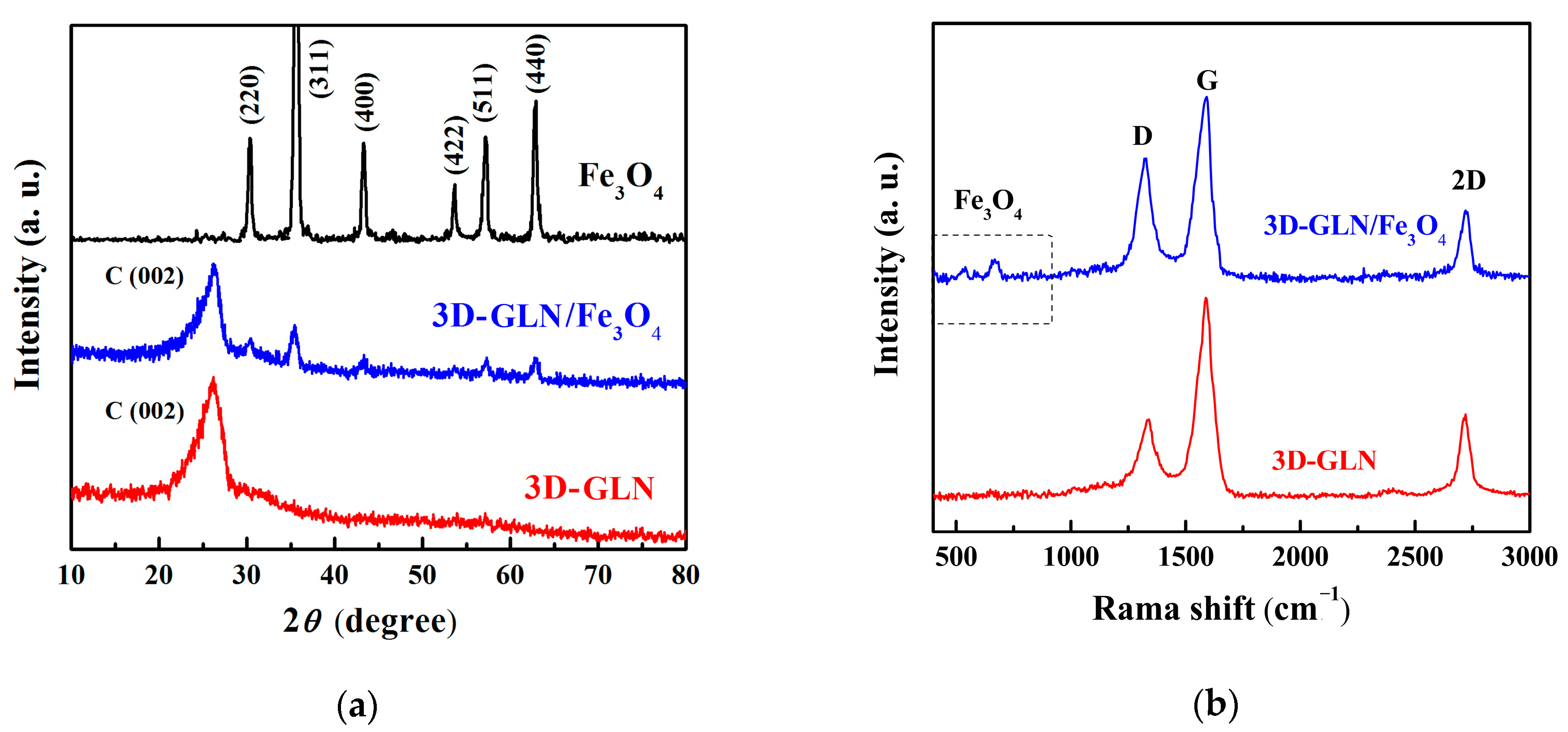
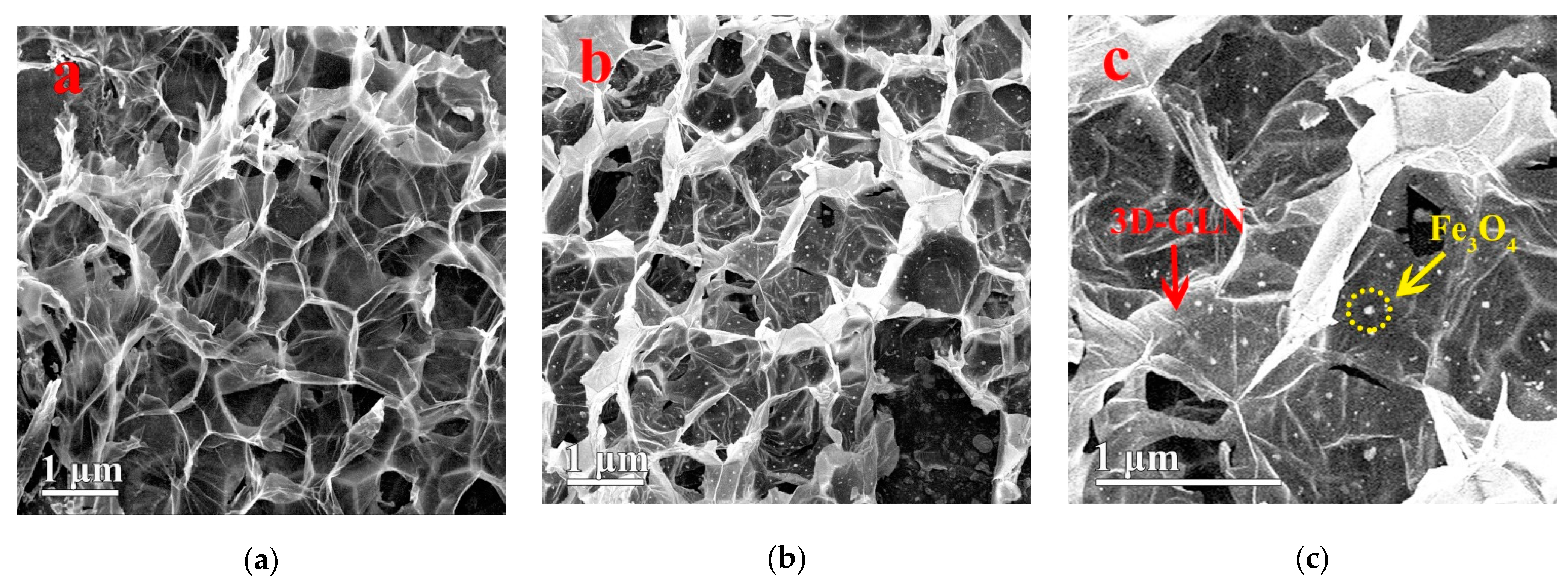


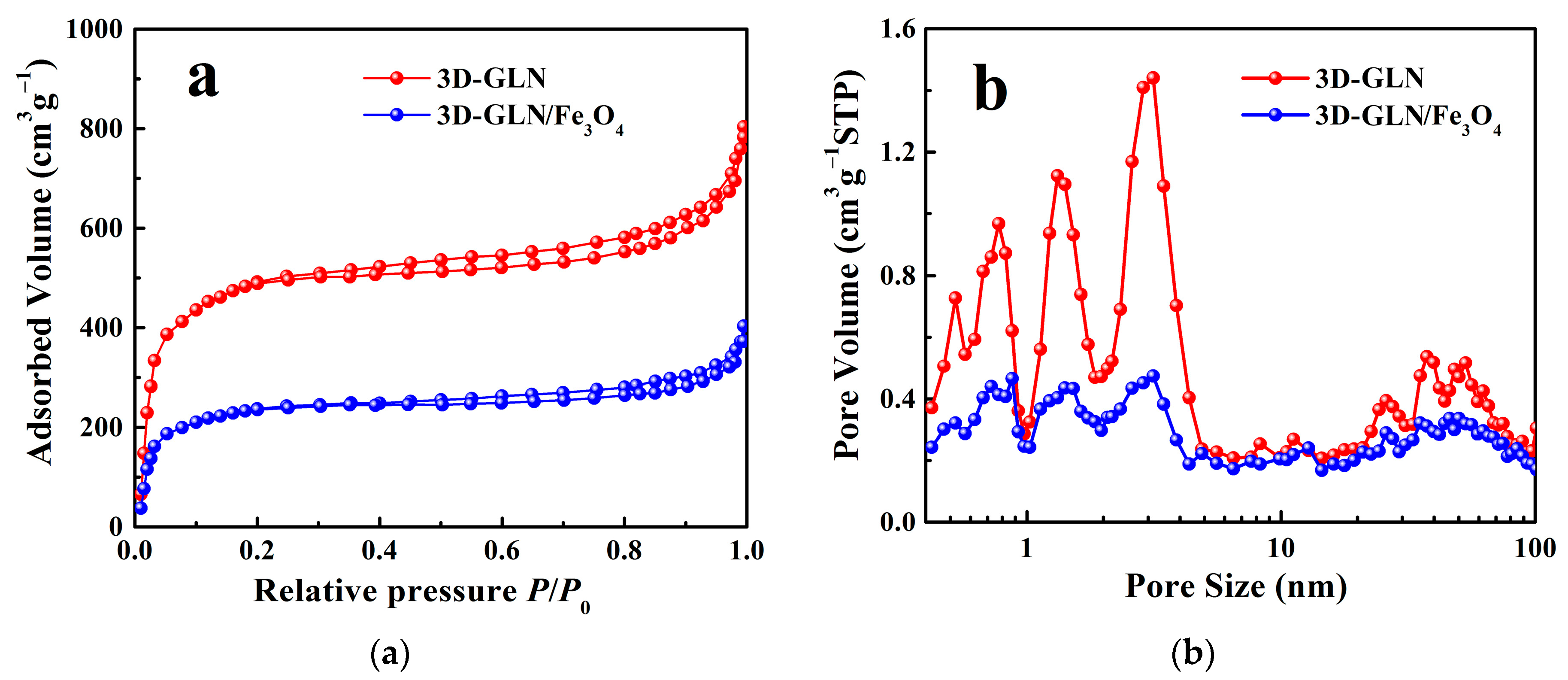

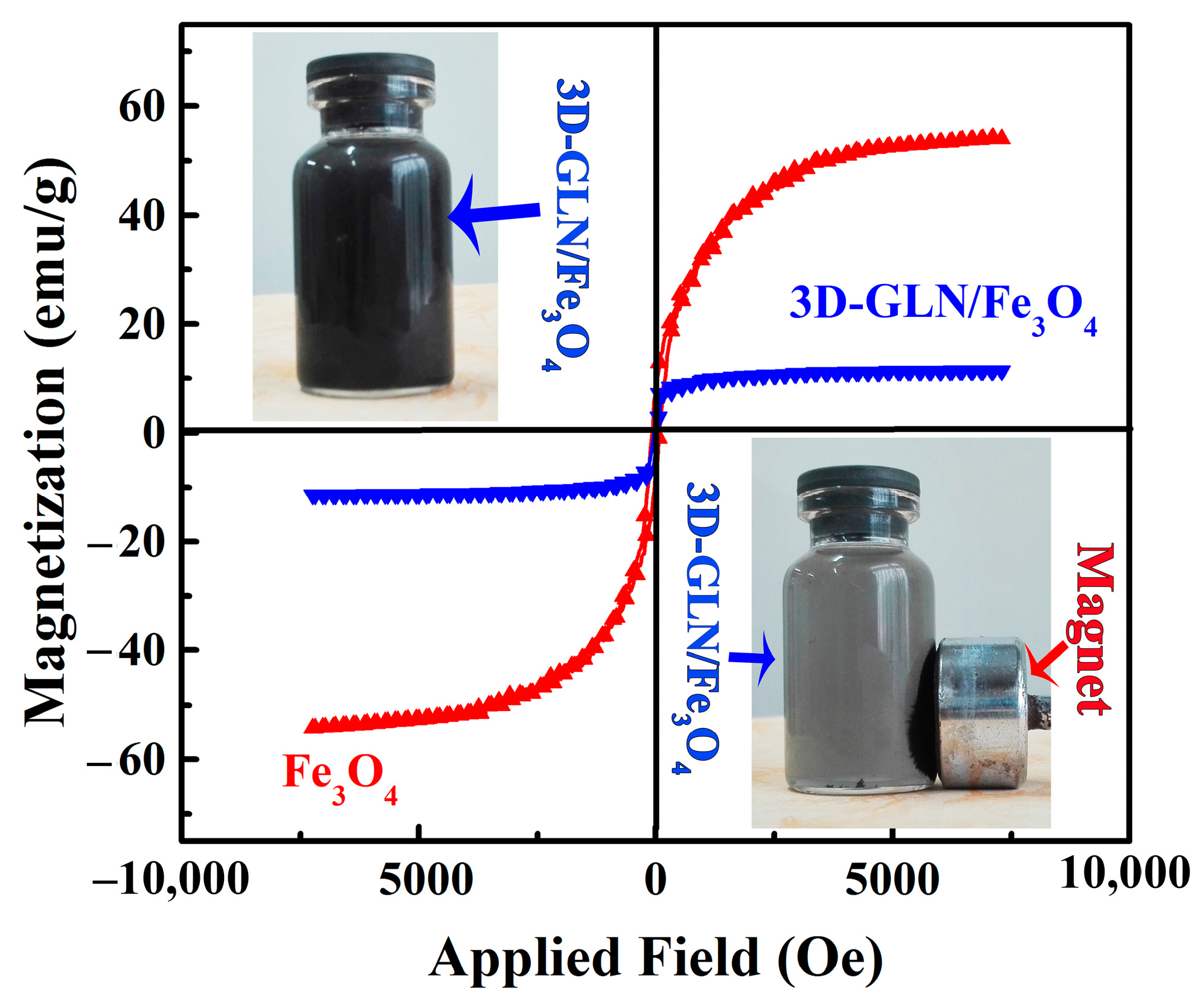

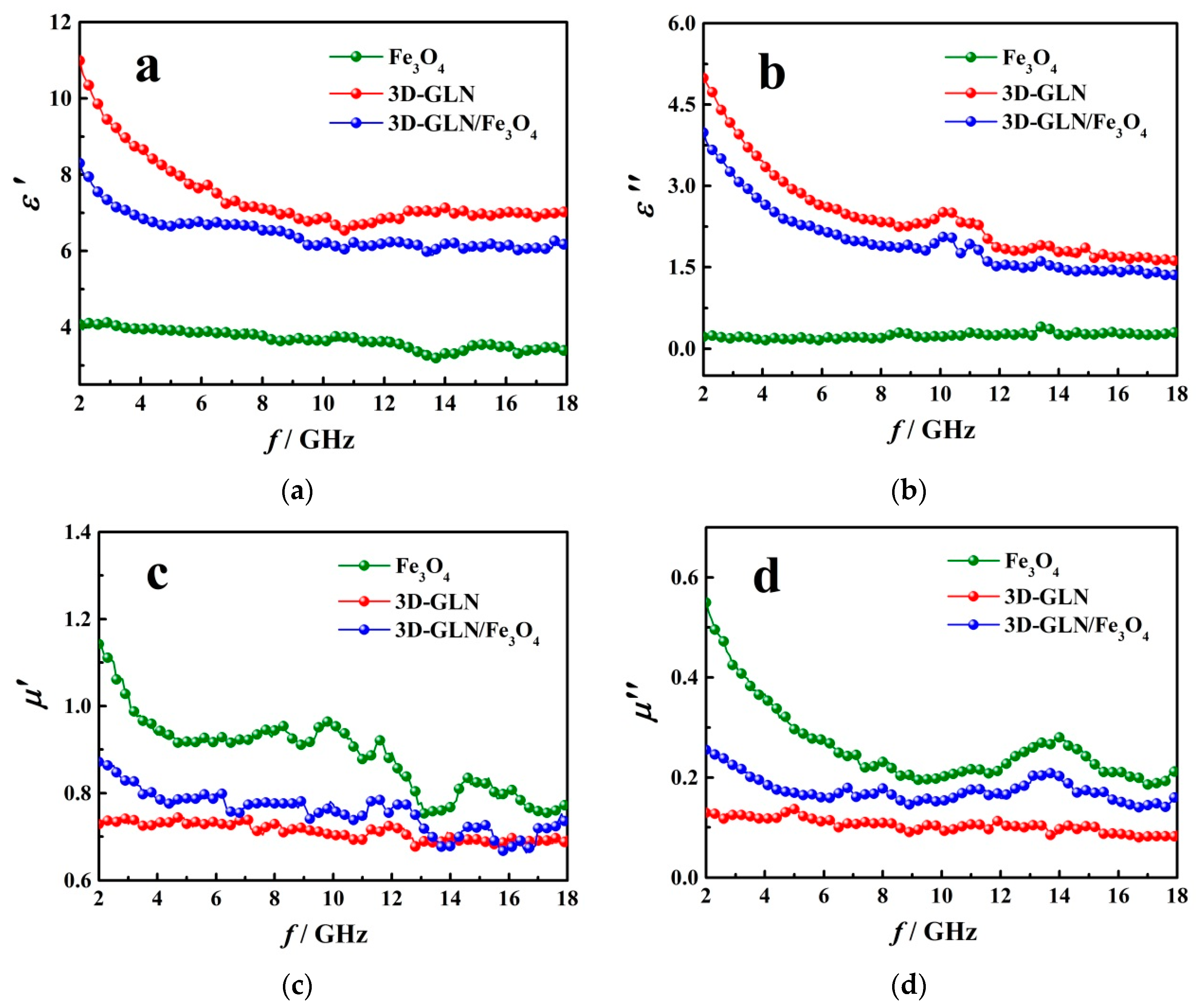
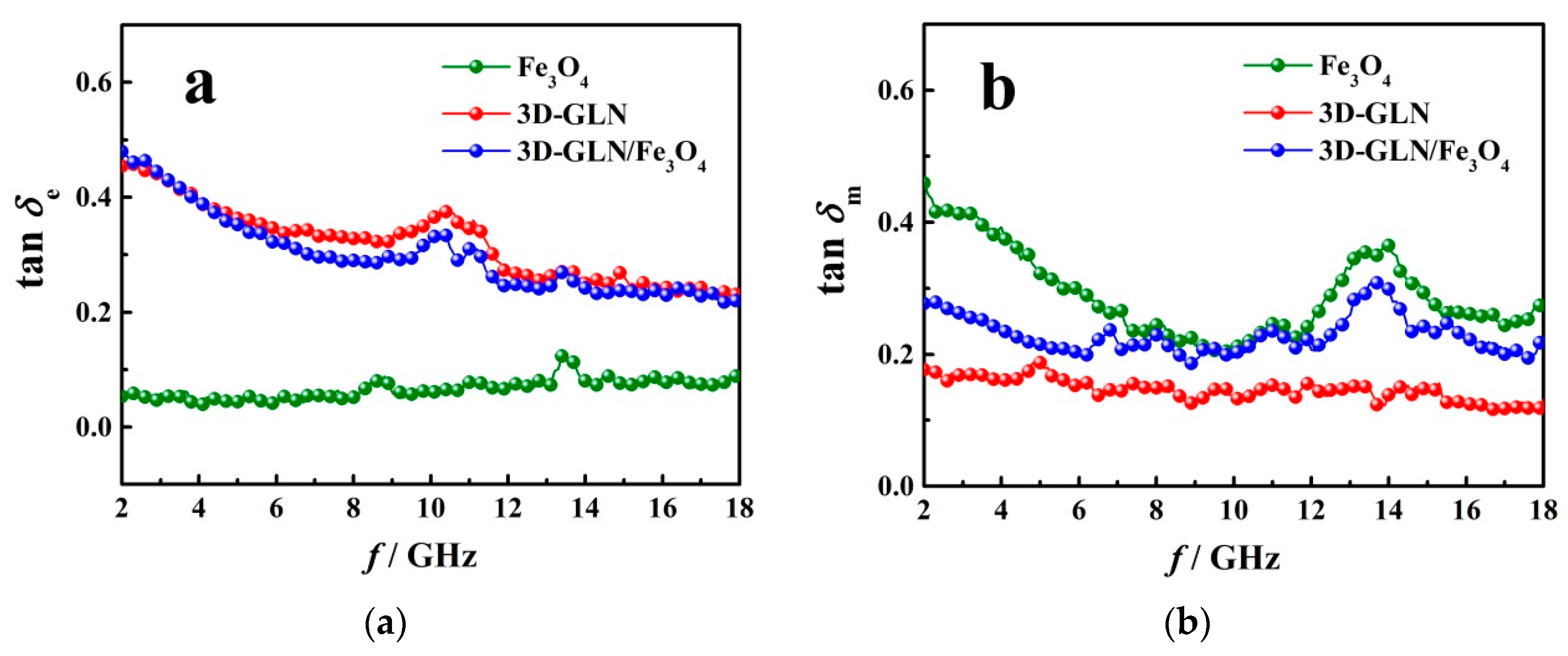

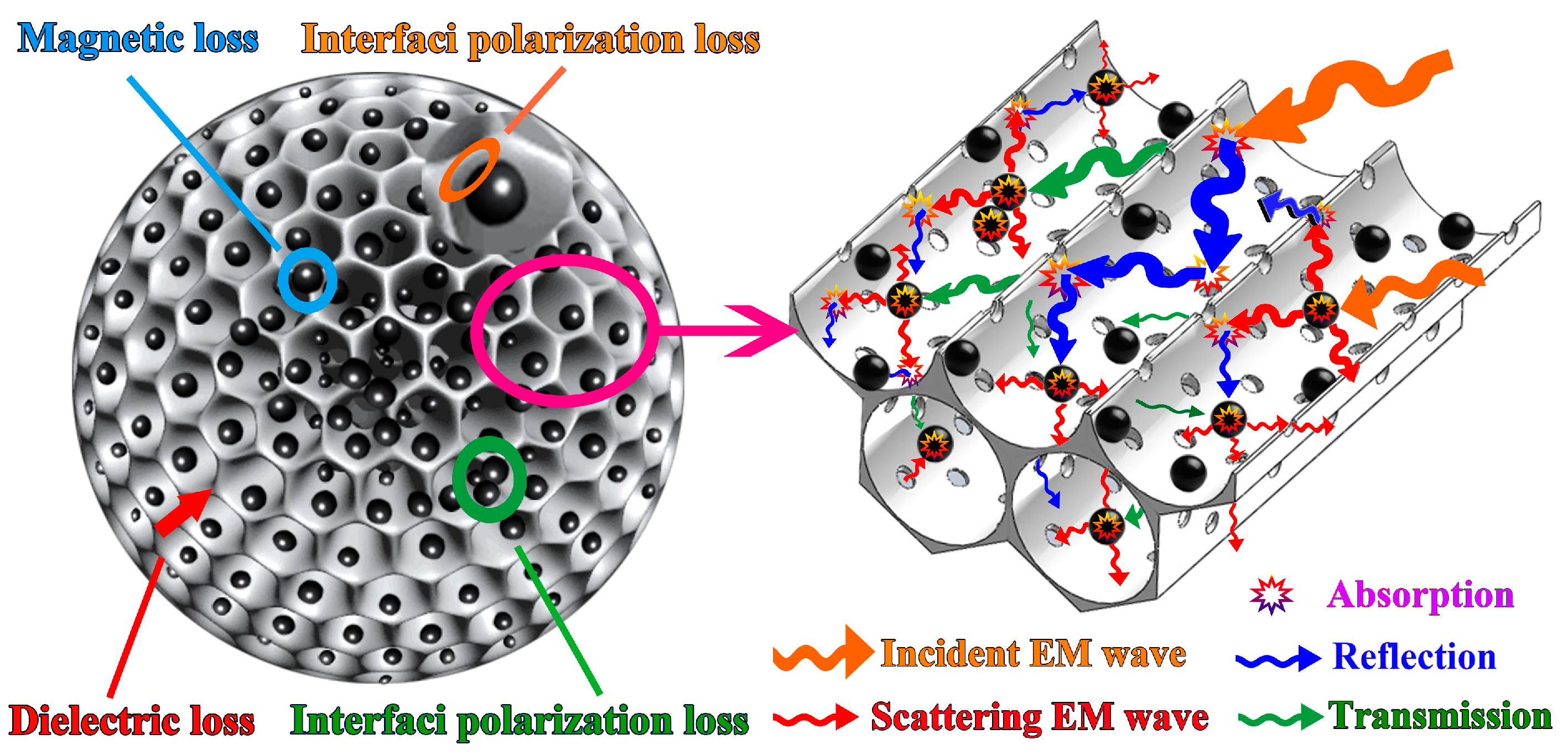
| Materials | Minimum RL | Effective Absorption Bandwidth fe | Reference |
|---|---|---|---|
| 3D-GLN | −34.75 dB | 3.3 GHz | This work |
| 3D-GLN/Fe3O4 | −46.8 dB | 4.4 GHz | This work |
| 3D graphene–Fe3O4 nanocomposites | −23.0 dB | 4.8 GHz | [6] |
| 3D graphene@Fe3O4@Ppy | −40.53 dB | 5.12 GHz | [28] |
| 3D interlinked ACNT/RGO/BaFe12O19 | −19.03 dB | 3.8 GHz | [29] |
| Fe3O4/rGO | −22.7 dB | 3.13 GHz | [2] |
| rGO-Fe3O4 nanocomposites | −37.5 dB | 1.9 GHz | [30] |
| Hollow Fe3O4@ RGO | −41.89 dB | 4.2 GHz | [31] |
| Graphene@Fe3O4@PANI@WO3 | −46.8 dB | 1.8 GHz | [32] |
| Fe3O4/SiO2/graphene | −27.1 dB | 2.5 GHz | [33] |
Publisher’s Note: MDPI stays neutral with regard to jurisdictional claims in published maps and institutional affiliations. |
© 2021 by the authors. Licensee MDPI, Basel, Switzerland. This article is an open access article distributed under the terms and conditions of the Creative Commons Attribution (CC BY) license (https://creativecommons.org/licenses/by/4.0/).
Share and Cite
Shang, T.; Lu, Q.; Zhao, J.; Chao, L.; Qin, Y.; Ren, N.; Yun, Y.; Yun, G. Novel Three-Dimensional Graphene-Like Networks Loaded with Fe3O4 Nanoparticles for Efficient Microwave Absorption. Nanomaterials 2021, 11, 1444. https://doi.org/10.3390/nano11061444
Shang T, Lu Q, Zhao J, Chao L, Qin Y, Ren N, Yun Y, Yun G. Novel Three-Dimensional Graphene-Like Networks Loaded with Fe3O4 Nanoparticles for Efficient Microwave Absorption. Nanomaterials. 2021; 11(6):1444. https://doi.org/10.3390/nano11061444
Chicago/Turabian StyleShang, Tao, Qingshan Lu, Jianjun Zhao, Luomeng Chao, Yanli Qin, Ningyu Ren, Yuehou Yun, and Guohong Yun. 2021. "Novel Three-Dimensional Graphene-Like Networks Loaded with Fe3O4 Nanoparticles for Efficient Microwave Absorption" Nanomaterials 11, no. 6: 1444. https://doi.org/10.3390/nano11061444
APA StyleShang, T., Lu, Q., Zhao, J., Chao, L., Qin, Y., Ren, N., Yun, Y., & Yun, G. (2021). Novel Three-Dimensional Graphene-Like Networks Loaded with Fe3O4 Nanoparticles for Efficient Microwave Absorption. Nanomaterials, 11(6), 1444. https://doi.org/10.3390/nano11061444







